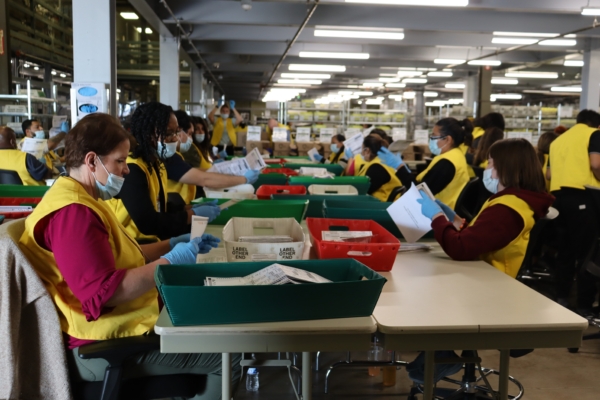As of November 21st, 16 days after the election day, the “Ballots Counted/Registered Voters Total” (voter turnout) in all 58 counties of California has reached 70.1%, compared to only 35% during the primary elections. This indicates that more Californians participated in the 2024 election. The total registered voters for the general election in California is close to 22.6 million, which is an increase of 518,000 from the primary elections in March.
In six counties of California with over 1 million registered voters, Los Angeles County has over 5.74 million registered voters, accounting for 25.4% of the total voters in California with a turnout rate of 65.9%. San Diego County has over 1.98 million registered voters with a turnout rate of 75.2%, Orange County has over 1.86 million with a turnout rate of 75.3%, Riverside County has over 1.37 million with a turnout rate of 68.5%, San Bernardino County has over 1.19 million with a turnout rate of 62.6%, and Santa Clara County has over 1.04 million with a turnout rate of 72.7%.
The registered voters in these six populous counties account for more than half of the total registered voters in California, essentially determining the voting trend. Moreover, Alameda County has over 961,000 registered voters, Sacramento County has nearly 890,000, Contra Costa County has close to 723,000, while Fresno County, San Francisco County, and Ventura County also have over 500,000 registered voters.
As of November 21st, California saw the passing of Propositions 2, 3, 4, 34, 35, and 36 among the 10 ballot measures, while Propositions 5, 6, 32, and 33 were rejected. Proposition 32, which aimed to raise the minimum wage to $18, had more than 7.13 million supporters, comprising 49.2%, while opponents exceeded 7.537 million, making up 50.8%. Proposition 34, requiring 98% of the revenue from the Medi-Cal Rx program to be used for patient care, had over 7.22 million supporters, accounting for 50.8%, and opponents were close to 6.99 million, representing 49.2%. Although the votes were very close, the counting process was approaching the end, making a reversal less likely.
Proposition 36, which proposed “felony charges and mandatory treatment for certain drug and theft crimes”, had the highest approval rating and received support from many lawmakers of both parties. California residents strongly condemned “zero-dollar bail” or not penalizing thefts below $950. The initiative during signature collection was called the “Homelessness, Drug Addiction, and Theft Reduction Act”, aiming to partially amend the Proposition 47 of 2014, also known as the “Safe Neighborhoods and Schools Act”. Many voters expressed feeling misled initially and believed that the proposition would impose stricter penalties on repeat offenders of theft and trafficking of fentanyl and other drugs.
As of November 21st, in the 20 state senate seats in California, the Democratic Party won 16 seats, while the Republican Party is expected to secure 4 seats in Districts 1, 19, 23, and 37. There are a total of 12 new state senators, including representatives from both parties, surpassing the halfway mark.
Additionally, in District 37, Steven “Steve” Choi (R) holds a slight lead with 50.7% (230,131 votes) over incumbent Josh Newman (D) at 49.3% (223,924 votes). In District 29, Eloise Gomez Reyes (D) won with 57.2%.
In the state assembly, as of November 21st, the Democratic Party secured 61 seats out of 80, while the Republican Party may obtain 19 seats. There are a total of 21 new state assembly members from both parties.
In District 36, Jeff Gonzalez (R) is leading with 51.7% over Jose “Joey” Acuña Jr. (D); in District 47, incumbent Greg Wallis (R) leads with 51.1% against Christy Holstege (D) at 48.9%; and in District 58, Leticia Castillo (R) is ahead with 50.2% over Clarissa Cervantes (D) at 49.8%, with a gap of only 504 votes.
In District 32, incumbent Vince Fong (R) is leading with 59% over Ken Weir (R). However, Fong has already secured a seat in the 20th Congressional District, necessitating a special election for District 32.

